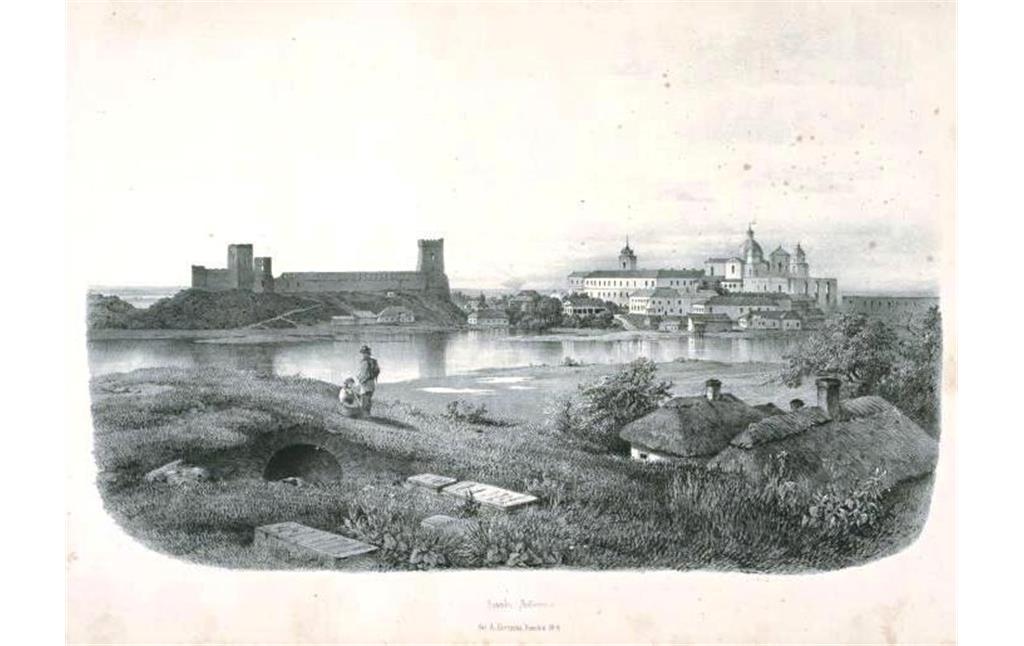
Triad of founders
The stone castle was built by order of the Lithuanian Prince Lyubart (also Liubartas, baptized name Demetrius, c. 1312-1383) in the second half of the 14th century (some historians believe that Lyubart was the last prince of the Kingdom of Galicia-Volhynia (1199-1349)). On the Styr River a dam was created so that the future building would be on a certain island, and also a drawbridge was built. Ambitions of the Polish King to conquer Volhynia prompted Lyubart to equip Lutsk as a new capital and properly strengthen its defense. Even today, most of the city's residents call the building Lyubart’s Castle.
The castle consisted of two fortifications – the Upper Castle and the Lower, or Okolnyi Castle. The Entrance Tower (also known as Lyubart's Tower) of the Upper Castle was raised by one tier and Styrova Tower was laid. A three-story Prince’s Palace was built and a stone Orthodox Church of St. Ivan Bogoslov (built in the second half of the 12th century) was located in the castle courtyard. The territory of the wooden Lower Castle was built up with courtyards of officials, bishops and other nobility close to Lyubart. In two castles, all the governing bodies of the principality (legislative, executive, judicial, and church) were concentrated.
The Lithuanian Prince Vitovt (also Vytautas, baptized name Oleksandr, 1354/1355-1430) spent a lot of time in Lutsk, so the Upper Castle received the status of Vitovt's residence. Together with Vitovt, Karaites, Jews, Germans and Armenians came to Lutsk. Trade was raging in the castle, and streets, shopping arcades, churches, synagogues were gradually formed around the castle. The Bishop's Tower (also known as Vitovt's Tower) with a sharp gothic roof was built and the walls finally closed the ring between all three towers of the castle. The castle plan resembled an equilateral triangle with 12 Meter high and three Meter thick walls. A wooden Church of the Holy Trinity was built in the Lower Castle.
At the time of the entry of Lutsk into the possession of the Prince Svydrygailo (also Švitrigaila, baptized name Boleslav, c. 1370-1452), the Upper Castle was completely brick-built. The Lutsk War of 1431 showed that the castle walls, which ended with merlon battlements with spike-like loopholes, were unsuitable for bulky castle rifles. Therefore, the walls were enlarged and Styrova Tower (also known as Svydrygailo’s Tower) was raised to the height of the Entrance and Bishop’s Towers.
In the following centuries, the Upper as well as the Lower Castle had not changed much. Since the 16th century, parts of the Lower Castle had become brick-built. In the rooms of the Upper Castle or in the Church of St. Ivan Bogoslov, the meetings of all the courts took place. At the beginning of the 17th century, a Jesuit Church with a collegium was built in the territory of the Lower Castle. After a fire in the 1780s, the Lower Castle actually ceased to exist and therefore only the Upper Castle is called Lutsk Castle.
Medieval „summit” of European leaders in Lutsk Castle
The city and the castle received special fame during the time of the Prince Vitovt who turned Lutsk into the second, after Vilna (today: Vilnius), capital of one of the largest European states of the late middle ages.
In 1429, a congress of the most powerful monarchs of Europe took place in Lutsk, after which the city was put on European maps and received Magdeburg Law. The congress discussed the problems of Poland's participation in the anti-Turkish campaign, the position taken by the Moldavian Principality on this issue, the Hussite movement in the Czech Republic, territorial disputes and the like. For the first time, the question of the coronation of the owner of the Grand Duchy of Lithuania was officially raised. But the congress did not have any noticeable political consequences. Some researchers questioned the scope of this event, since, from their point of view, at that time it was physically impossible to accommodate 15.000 people in Lutsk, who, according to various written sources, arrived to participate in the congress. However, the problem was solved quite effectively: the guests were settled and fed in the villages and towns adjacent to the city.
Lutsk Castle during World War II
The German invasion of the Soviet Union started on June 22, 1941; the German army occupied the city of Lutsk on June 26, which had the biggest Jewish community in the Volhynian Voivodeship (1931: 48.5 % of the total population). In the following weeks, mass executions and other murders on Jews took place in the city and on July 4, 3.000 Jews were massacred inside the castle walls.
Pearl of the old town
Lutsk Castle is the main building of the State Historical and Cultural Reserve “Old Lutsk”. In the Upper Castle, tourists can inspect walls, towers, bridge in front of the Entrance Tower, foundations and catacombs of the Church of St. Ivan Bogoslov, remains of the Prince’s Palace, Bishop’s House, etc., visit museums (of bells, books and art), exhibitions and an observation deck on the roof of the Entrance Tower. Festivals, knight tournaments and scientific conferences are often held here. Near the Upper Castle, there is the Saint Peter and Paul Cathedral with catacombs open to visitors. From the Lower Castle, only the Chartoryiski’s Tower has been preserved, which, together with the remains of the defense complex, is adjacent to the building of the Jesuit Church.
(Maryana Senkiv, ukrainer.net & Lviv Polytechnic National University; Jörn Schultheiß, Hochschule Geisenheim University, 2020; Special thanks to ukrainer.net))
Internet sources
de.wikipedia.org: Liubartas-Burg
en.wikipedia.org: Kingdom of Galicia–Volhynia
en.wikipedia.org: Liubartas
en.wikipedia.org: Lubart's Castle
en.wikipedia.org: Lutsk Ghetto
en.wikipedia.org: Švitrigaila
karpaty.love: Замок Любарта в Луцьку
























